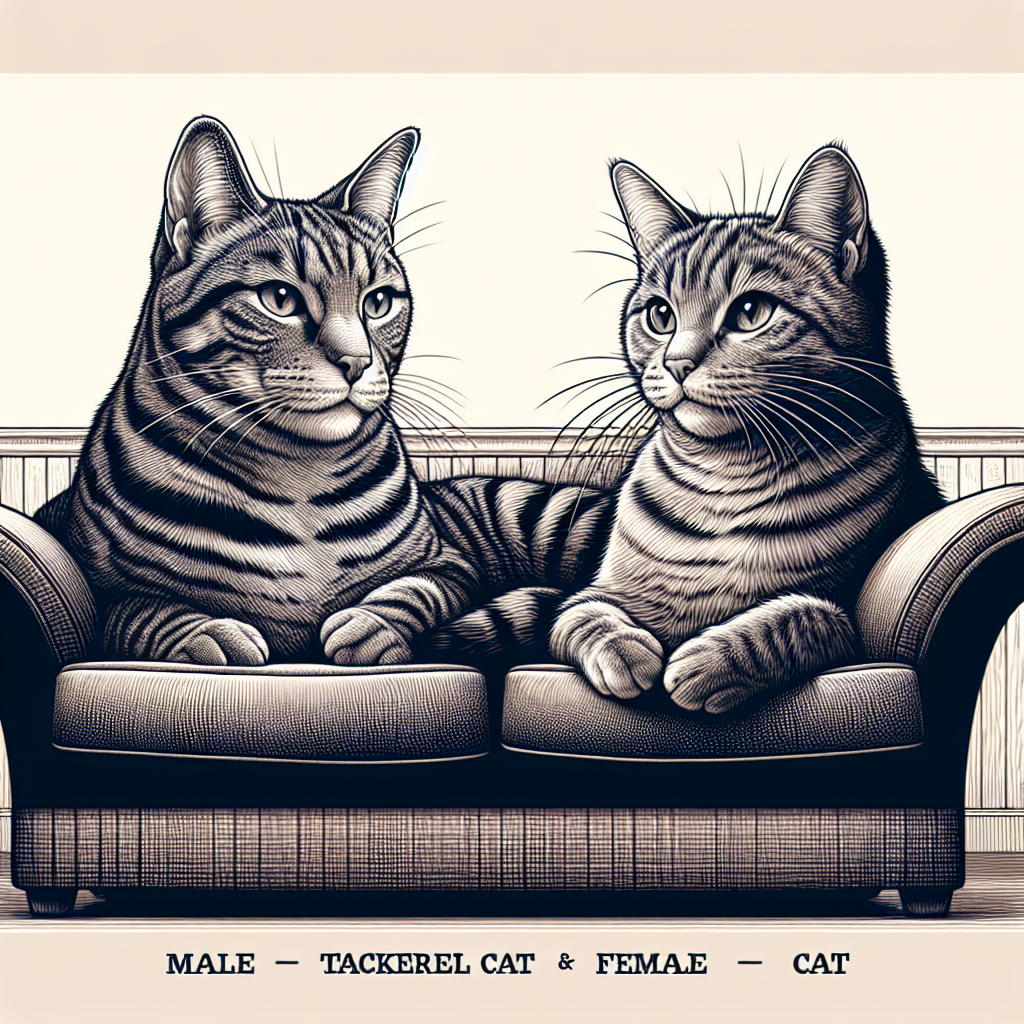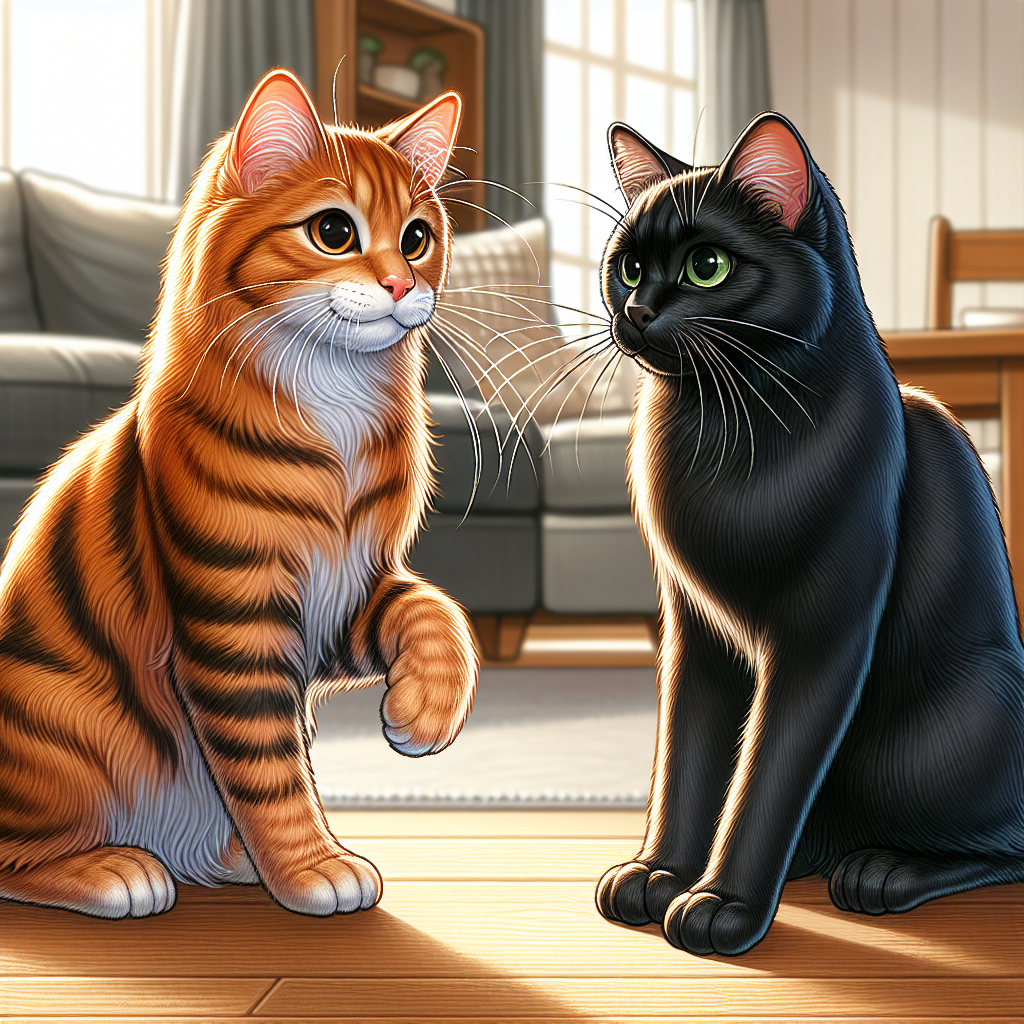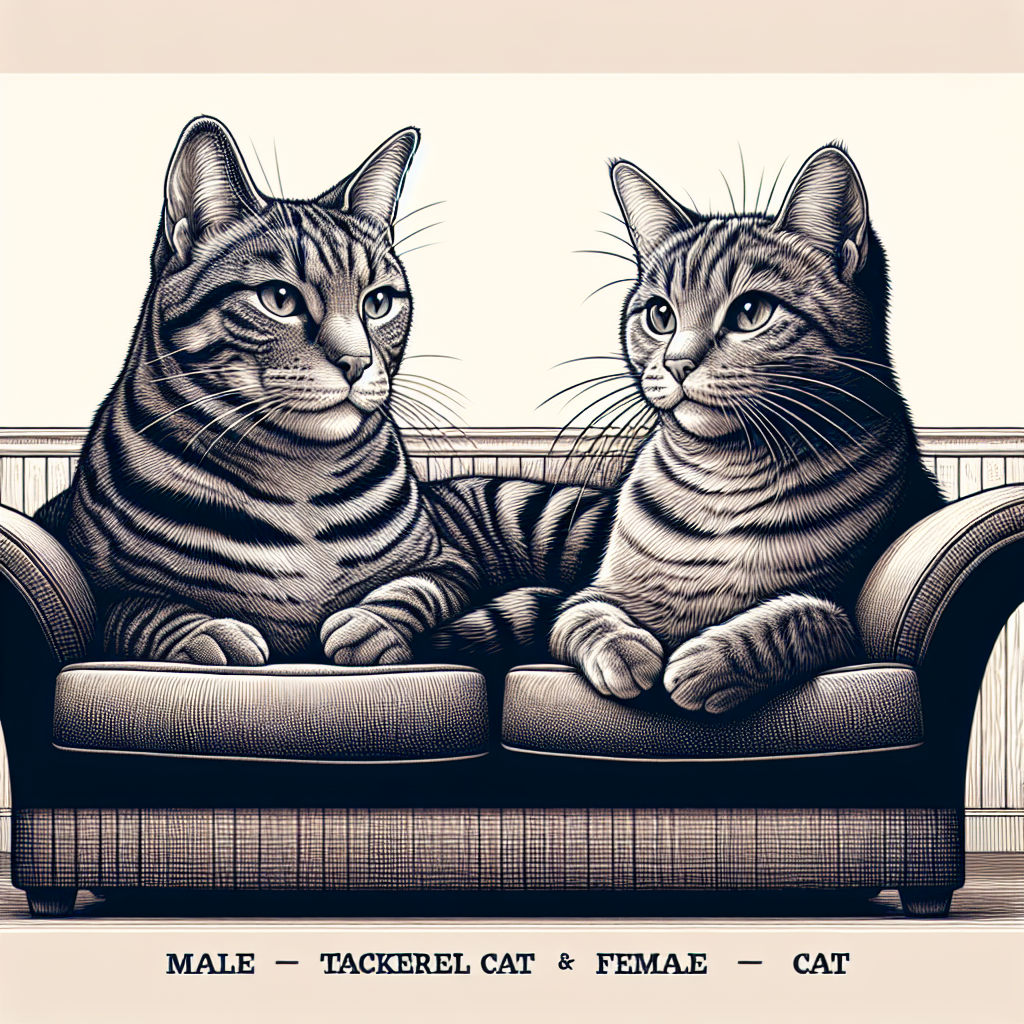If you’re a cat lover considering adding a new furry member to your family, you might be wondering about the dynamics between male tabby cats and their female counterparts. We all want our pets to get along harmoniously and create a happy and peaceful home. In this article, we’ll explore the fascinating world of male tabby cats and their potential compatibility with female cats, shedding light on their behaviors, temperaments, and tips for successful coexistence. So, let’s find out if male tabby cats are a perfect match for their female companions.
Physical Characteristics of Male Tabby Cats
Coat Patterns
Male tabby cats, like their female counterparts, can display various coat patterns. Tabby cats are known for their distinctive markings, which can include swirls, stripes, and spots. These patterns may be present in different colors, such as brown, gray, orange, and black. The unique coat patterns of male tabby cats not only add to their aesthetic appeal but also contribute to their individuality and distinguish them from other cat breeds.
Size and Weight
When it comes to size and weight, male tabby cats tend to be slightly larger and heavier than their female counterparts. On average, male cats are around 10 to 20% larger than female cats. This size difference is more prominent in some cat breeds, including tabbies. However, it’s important to note that there can be variations within each breed, and individual cats may not always conform to these generalizations. It’s always best to focus on the specific cat’s individual characteristics rather than relying solely on gender-based assumptions.
Territorial Behavior
Male tabby cats, like many other male cats, can exhibit territorial behavior. This behavior is rooted in their instinctual nature to mark and defend their territory. Male cats may engage in behaviors such as urine spraying, scratching, and vocalizing to assert their dominance and protect their claimed space. However, the extent of territorial behavior can vary from cat to cat, depending on various factors such as age, neutering status, and individual temperament. Understanding and addressing a male tabby cat’s territorial instincts is crucial when introducing them to a female cat or incorporating them into a multi-cat household.
Social Nature of Female Cats
Female Cat Hierarchy
Female cats, including tabbies, have a hierarchical social structure within their groups. They establish a pecking order that helps maintain peace and stability among members. The female cat hierarchy is usually based on factors such as age, social skills, and assertiveness. The dominant female cat typically holds the highest status, while the others follow in a descending order. This hierarchy can play a role in how female cats interact with male cats and influence the dynamics of their relationships.
Maternal Instincts
Female tabby cats, like other female cats, are known for their strong maternal instincts. They have a natural nurturing instinct that kicks in when they give birth or encounter young kittens. Even if they are not mothers themselves, female cats may display motherly behavior towards other kittens or even human caretakers. This instinct can also extend to male cats, as female tabbies may sometimes exhibit caregiving behaviors towards their male counterparts, creating a nurturing bond between them.
Prone to Estrus or Heat
Female tabby cats, like all female cats, experience estrus or “heat” cycles. This reproductive phase typically occurs every two to three weeks, and during this time, the female cat becomes sexually receptive. She may display behavioral changes such as restlessness, increased affection, and vocalization to attract potential mates. Understanding the heat cycles of female tabbies is crucial when considering introducing a male tabby into their environment, as it can affect their behavior and dynamics with male cats.

Understanding Cat Behavior
Importance of Socialization
Socialization plays a crucial role in shaping a cat’s behavior and their ability to interact positively with other cats. It involves exposing them to different experiences, people, and animals from a young age, helping them develop the necessary social skills to navigate their surroundings. By providing ample opportunities for socialization, including positive interactions with other cats, owners can help their male and female tabbies develop a balanced and friendly approach towards each other.
Influence of Sterilization
Sterilization, particularly neutering in male cats and spaying in female cats, can have a significant impact on their behavior and interactions with other cats. Neutering male tabby cats helps reduce territorial aggression, roaming tendencies, and unwanted mating behaviors. Spaying female tabbies not only eliminates the heat cycles but also minimizes the likelihood of territorial disputes with male cats. Sterilization plays a crucial role in creating a more harmonious environment for male and female cats to coexist peacefully.
Role of Age and Personality
Age and personality traits play a significant role in how male and female tabby cats interact with each other. Younger cats, whether male or female, tend to be more adaptable and open to socializing with other cats. Older cats may be set in their ways and less inclined to readily accept new companions. The personality of each individual cat also influences their compatibility with other cats. Some cats may be more outgoing and sociable, while others may be more reserved and prefer solitude. Understanding the age and personality of each cat involved is crucial when considering their compatibility and potential for positive interactions.
Factors Affecting Male-Female Cat Relationships
Individual Cat Personalities
Just like with humans, the compatibility between male tabby cats and female cats relies heavily on their unique personalities. Some male tabbies may have a more dominant or assertive nature, while others may be more laid-back and docile. Similarly, female cats can display a range of personalities, from confident and outgoing to shy and timid. It’s essential to consider the individual personalities of the cats involved, as they can greatly influence the dynamics and compatibility of their relationships.
Shared Territory and Resources
Sharing territory and resources is a significant factor in establishing harmonious relationships between male and female tabby cats. Providing separate spaces for each cat, such as individual sleeping areas, litter boxes, and feeding stations, helps reduce potential conflicts and territorial disputes. Cats are naturally territorial animals, and ensuring they have their own designated areas allows them to feel secure and minimizes the likelihood of resource guarding or aggressive behavior.
Introducing New Cats
Introducing a male tabby cat to a female cat should be done gradually to increase the chances of a positive relationship. The cats should initially be kept in separate spaces, gradually introducing their scents through scent swapping techniques. Visual exchanges can also be helpful, such as allowing the cats to see each other from a safe distance. Slowly increasing their proximity and supervised interactions can help them become accustomed to each other’s presence and potentially form a bond over time. Patience is key during this process, as each cat may require different amounts of time to adjust to the new addition.

Positive Interactions Between Male Tabby and Female Cats
Bonding and Socialization
Male tabby cats can form strong bonds with female cats through positive interactions and socialization. By providing opportunities for supervised play sessions and shared activities, such as interactive toy play or puzzle feeders, male and female tabbies can build a bond based on mutual enjoyment. Regular positive interactions, coupled with gradual introduction and reinforcement of good behavior, can help establish a harmonious relationship between male and female cats.
Play and Hunting Behaviors
Play and hunting behaviors are important aspects of a cat’s natural instincts and can be key components in fostering positive interactions between male tabby cats and female cats. By engaging in interactive play sessions with appropriate toys, such as feather wands or puzzle toys, owners can encourage male and female tabbies to play together. These playful interactions mimic hunting behaviors and can help build trust, reduce stress, and create a sense of camaraderie between the cats.
Mutual Grooming
Mutual grooming or allogrooming is a behavior commonly observed among bonded cats, regardless of their gender. Grooming rituals allow cats to bond, establish social hierarchies, and reinforce their relationships. Male tabby cats may engage in mutual grooming with female cats as a way to demonstrate their affinity and establish a sense of trust and familiarity. This grooming behavior can enhance the emotional bond between male and female cats, creating a positive and harmonious dynamic within their relationship.
Potential Challenges in Male-Female Cat Relationships
Territorial Disputes
Territorial disputes can be one of the main challenges faced in male-female cat relationships. Both male and female tabby cats can display territorial behaviors, especially when confronted with a new cat in their environment. These disputes can manifest as aggression, urine marking, or territory guarding. Creating separate spaces and gradually introducing the cats can help minimize territorial conflicts and give each cat a sense of security within their designated areas.
Mating Behavior
Male tabby cats, if not neutered, can exhibit mating behaviors that may not be well-received by female cats. During the female cat’s heat cycle, intact male cats may become more persistent in their attempts to mate, which can potentially cause stress and discomfort for the female. Neutering male tabbies not only prevents unwanted pregnancies but also curbs their mating behaviors, making them more compatible with female cats in a shared environment.
Competitive Aggression
In some cases, male and female cats may display competitive aggression towards each other. This aggressive behavior can stem from a perceived threat to resources, territory, or social status within the household. Observing and addressing signs of competitive aggression, such as hissing, growling, or swatting, is crucial to create a more peaceful coexistence between male tabby and female cats. Identifying the triggers and providing sufficient resources and space for each cat can help alleviate competitive aggression over time.
Tips for Introducing a Male Tabby Cat to a Female Cat
Gradual Introduction and Supervision
When introducing a male tabby cat to a female cat, it’s important to proceed slowly and supervise their interactions closely. Begin by keeping the cats in separate spaces, gradually introducing their scents by swapping bedding or using pheromone diffusers to create a sense of familiarity. Over time, allow them to have supervised visual exchanges and controlled interactions, gradually increasing their time together. By closely monitoring their behavior during these introductions, owners can ensure the safety and well-being of both cats.
Using Scent and Visual Exchange
Using scent and visual exchanges can aid in the introduction process between male tabby and female cats. Cats rely heavily on their sense of smell, and by allowing them to familiarize themselves with each other’s scent, they can become more accepting of the new presence. This can be done by rubbing each cat with a soft cloth and offering it to the other cat to investigate. Additionally, visual exchanges, such as using a baby gate or a cracked door, can provide a safe way for the cats to observe each other without direct contact.
Providing Separate Resources
Providing separate resources for each cat is crucial in minimizing potential conflicts and ensuring their well-being. Each cat should have their own feeding stations, litter boxes, and sleeping areas. Additionally, offering multiple scratching posts, toys, and hiding spots can help prevent resource guarding and allow each cat to have their own designated space. By ensuring that each cat has access to their necessities without competition, owners can promote a more harmonious environment for both male and female tabbies.
Creating a Harmonious Environment for Male and Female Cats
Spaying and Neutering
Spaying and neutering male and female tabby cats is essential for creating a harmonious environment. These procedures not only prevent unwanted pregnancies but also help minimize territorial behaviors, aggression, and mating-related issues. By removing the hormonal influences, both male and female cats can focus on building positive relationships and enjoying their shared living space without the distractions and possible conflicts associated with reproductive behaviors.
Environmental Enrichment
Environmental enrichment plays a vital role in ensuring the mental and physical well-being of both male and female cats. Providing a stimulating environment that offers opportunities for play, exploration, and mental engagement can significantly reduce stress and frustration, consequently promoting positive interactions between cats. Enrichment activities can range from interactive toys and puzzle feeders to cat trees, scratching posts, and perches that allow each cat to have their own space and engage in natural behaviors.
Time and Attention
Investing time and providing attention to both male and female tabby cats is crucial for fostering a fulfilling feline relationship. Cats thrive on human interaction and bonding, and regular play sessions, grooming, and cuddle time can help strengthen the bond between the cats and their human caretakers. By ensuring that each cat receives individual attention, while also facilitating positive interactions between them, owners can contribute to a harmonious environment where male and female tabbies can coexist happily.
Seeking Professional Advice for Cat Integration
Consulting with a Veterinarian
When considering introducing a male tabby cat to a female cat or addressing any challenges in their existing relationship, it’s beneficial to seek advice from a veterinarian. A veterinarian can provide guidance on issues such as health concerns, behavioral evaluations, and the appropriate timing for spaying and neutering. They can also recommend techniques to facilitate integration or offer medication options if behavioral issues arise. Consulting with a veterinarian ensures that the integration process is approached safely and in the best interest of both cats.
Hiring a Cat Behaviorist
For more specific and complex cases, hiring a professional cat behaviorist can provide invaluable assistance. Cat behaviorists are experts in understanding feline behavior and can tailor their guidance and recommendations to individual cats and their unique circumstances. They can assess the cats’ behavior, identify potential triggers or conflicts, and develop a customized plan to address any challenges or create a harmonious relationship between male and female tabbies.
Utilizing Online Resources
In addition to consulting professionals, there are also numerous online resources available to cat owners seeking guidance on integrating male and female tabbies. Websites, forums, and online communities dedicated to cat behavior and care can offer insights, success stories, and practical tips from experienced cat owners and experts. However, it’s essential to ensure the credibility and reliability of these sources before implementing any advice found online. Supplementing online information with professional guidance is recommended for the best outcomes.
Conclusion
Observing individual cat dynamics, being patient, and persevering through any challenges are key to establishing a fulfilling feline relationship between male tabby and female cats. Understanding the physical characteristics, social nature, and behavior of male and female tabbies is crucial for creating a harmonious environment where they can coexist happily. By considering factors such as individual personalities, proper introductions, and the provision of separate resources, owners can increase the chances of positive interactions and strengthen the bond between their male and female tabby cats. Seeking professional advice when needed and creating a stimulating and nurturing environment further enhances the potential for a rewarding relationship between male and female cats. With the right knowledge and approach, male and female tabby cats can thrive together and provide their owners with countless moments of joy and companionship.

